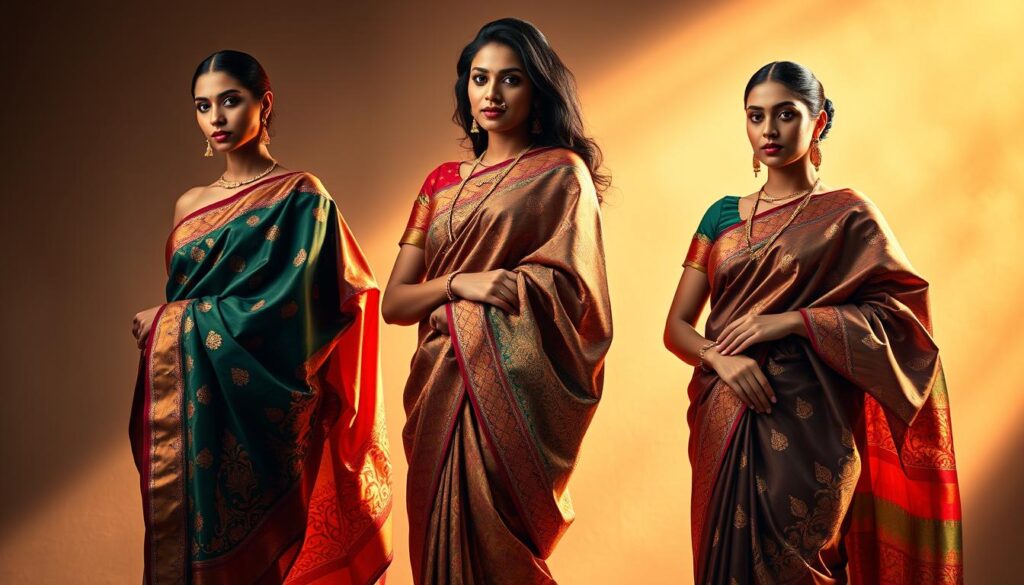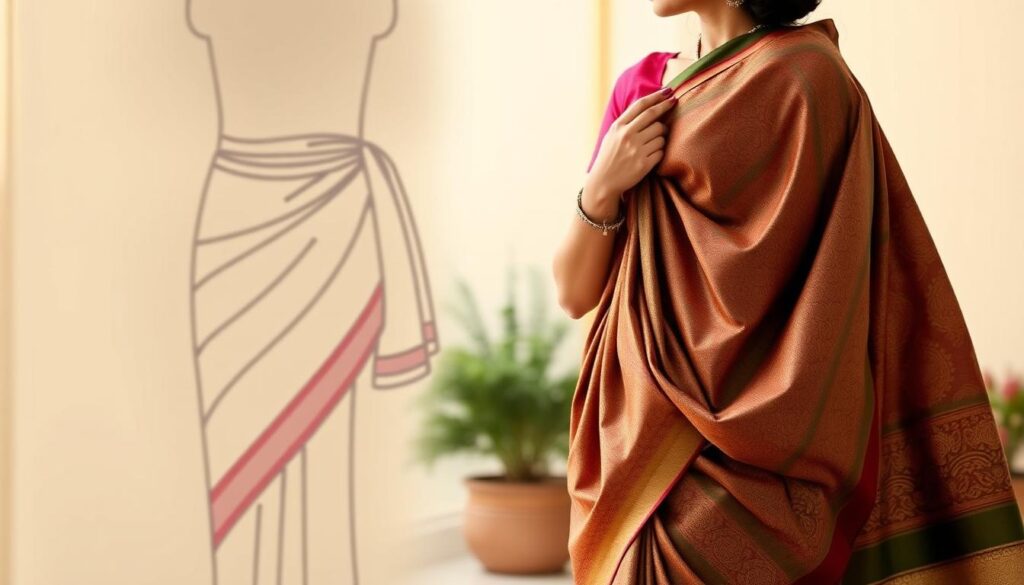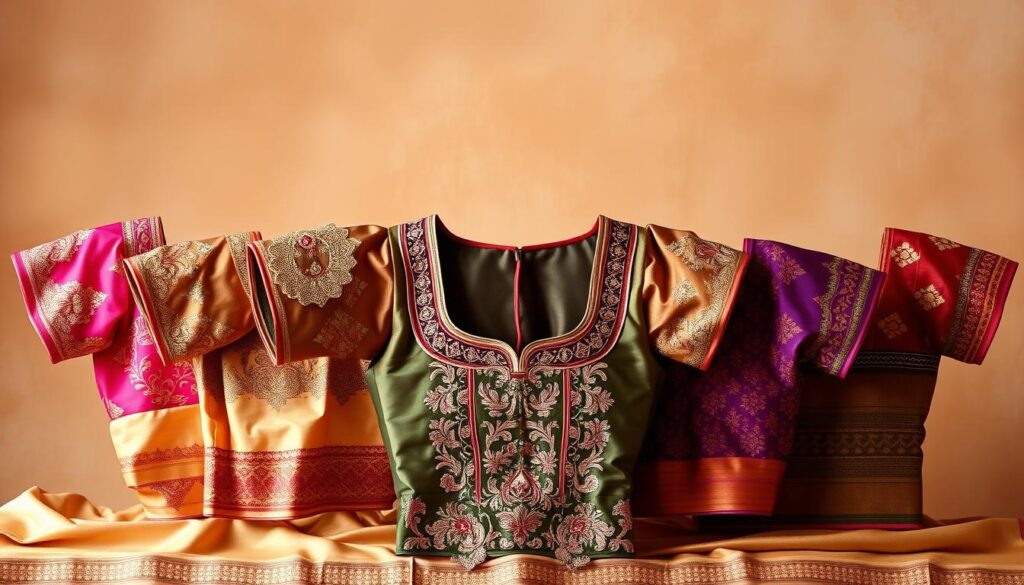Learning to wear a sari can change how you see fashion. It opens up a world of elegance and cultural richness. This guide makes wearing a sari easy for everyone, no matter your skill level.
The sari is more than clothes; it’s a way to express yourself. It celebrates centuries of culture. Each fold and drape shares a story, connecting you to India’s textile heritage.
Want to impress at a wedding or cultural event? Or just want to try something new? Wearing a sari lets you show your style while keeping a timeless tradition alive.
Feeling overwhelmed by the wrapping? Don’t worry. This guide will show you how to do it step by step. You’ll learn to wear a sari with ease and elegance.
Key Takeaways
- Understand the cultural significance of saris
- Learn fundamental draping techniques
- Discover how to select the right sari for your body type
- Master pleating and securing your sari
- Explore different styling options for various occasions
Understanding the Traditional Indian Sari
The sari is a stunning symbol of traditional Indian attire. It combines centuries of cultural heritage and artistic expression. This elegant garment is more than clothes; it’s a deep story of beauty, tradition, and identity.
Saris are not just fabric; they are stories passed down through generations. Each fold and weave holds deep cultural meaning. They can change to fit different places, social settings, and personal styles.
Origins and Cultural Significance
The sari’s history goes back to ancient times. It first appeared in early textile references from 2800-1800 BCE. Key historical insights include:
- Earliest mentions in Vedic Sanskrit texts
- Symbolic representation of feminine grace
- Cultural emblem of Indian heritage
Different Types of Sari Fabrics
Indian ethnic wear offers a wide range of sari fabrics, each with its own special qualities:
| Fabric Type | Origin | Key Characteristics |
|---|---|---|
| Silk | Varanasi | Luxurious, with detailed weaves |
| Cotton | Tamil Nadu | Light, easy to breathe |
| Chiffon | Mumbai | Soft, flows well |
Regional Variations in Sari Styles
Every Indian state adds its own special touch to traditional attire. From the Kanjeevaram of Tamil Nadu to the Banarasi of Uttar Pradesh, sari styles show local craftsmanship and cultural differences.
- South India: Vibrant silk saris
- West Bengal: Delicate Tant saris
- Gujarat: Vibrant Bandhani designs
Essential Items Needed for Wearing a Sari

Getting ready to wear a sari is more than just picking the fabric. Our sari fashion tips will guide you in gathering the right tools for a perfect look. Every little thing counts in making a stunning sari outfit.
Your sari toolkit needs key items for comfort, style, and confidence. Let’s look at what you’ll need:
- Petticoat: A fitted underskirt that’s the base for your sari drape
- Safety pins (various sizes)
- Blouse that goes well with your sari
- Shapewear for a smooth shape
- Matching accessories
The right petticoat is key in sari fashion tips. It should match your sari’s color and fit snugly around your waist. Pick a material that keeps it in place and gives your drape structure.
Safety pins are your go-to for sari styling. Get different sizes to hold pleats, adjust length, and avoid wardrobe mishaps. Tip: Carry a few extra pins in your clutch for quick fixes.
Your blouse choice can make or break your look. Pick a style that flatters your body and matches your sari’s vibe. Go for modern cuts that mix traditional charm with today’s trends.
Shapewear can be a big help in sari fashion tips. It smooths out your shape, making sure your sari drapes well and you feel great all night.
Choosing the Right Sari for Your Body Type
Finding the perfect sari is more than just picking fabric. Our guide will help you pick the best sari for your body shape. This way, you’ll look and feel amazing.

Knowing your body shape is key when choosing sari draping styles. Each shape can be transformed with the right style.
Body Shape Considerations
Each body type needs a special sari draping style to look stunning:
- Hourglass Figures: Show off your shape with fitted blouses and medium-weight fabrics
- Pear-Shaped Bodies: Go for light fabrics and vertical patterns for a slim look
- Athletic Builds: Use styles that add curves and a touch of femininity
- Petite Frames: Pick small prints and light materials to keep your look balanced
Color and Pattern Selection
Colors that match your skin tone make sari draping magical. Darker skin looks great in bright colors. Lighter skin can try pastels and neutrals.
Fabric Weight and Drape
The fabric’s weight changes how your sari looks and moves. Silk is elegant, chiffon is flowing, and cotton is comfy for daily wear. Choose a fabric that fits your body and the event.
How to Wear a Sari: Step-by-Step Guide
Learning to wear a sari might seem hard, but our guide will make you a pro in no time. Just be confident and patient.

- Prepare Your Foundation
- Start with a well-fitted petticoat (underskirt)
- Ensure the petticoat sits at your waist
- Tie the petticoat drawstring securely
- Position the Sari
- Hold the sari with the decorated end (pallu) on your right side
- Tuck the plain end into the petticoat at the right hip
- Make one complete round around your body
- Create Perfect Pleats
- Gather 5-7 uniform pleats
- Ensure pleats are facing the left side
- Tuck pleats neatly into the petticoat
- Drape the Pallu
- Bring the decorative end over your left shoulder
- Adjust the pallu to fall gracefully
- Secure with a decorative pin if needed
With practice, wearing a sari will become easy. Remember, confidence is key when wearing this beautiful traditional garment!
Mastering the Perfect Pleats

Draping a sari with pleats is an art that turns simple fabric into elegance. The key to a stunning sari is in the precise pleats. These pleats boost your look and keep the sari flowing gracefully.
Getting pleats right needs practice, patience, and some pro tips. Our guide will walk you through creating flawless sari pleats. You’ll look like a true fashionista.
Creating Even Pleats
To get perfect pleats, follow these steps:
- Start with a clean, flat surface
- Measure and mark your pleating points
- Use starch or light fabric stiffener for crisp folds
- Ensure consistent width between pleats
- Practice maintaining uniform pleat sizes
Securing Pleats Properly
Keeping pleats in place is key for a polished look. Here are some reliable methods:
- Use safety pins strategically
- Pin pleats at the waistband
- Create hidden internal folds for stability
- Use fabric clips for temporary positioning
Troubleshooting Common Pleating Issues
Draping a sari with pleats can be tricky. Common problems like uneven folds or slipping fabric can be fixed with these quick tips:
- Adjust pleat tension gradually
- Re-pin loose sections immediately
- Use fashion tape for stubborn fabrics
- Practice different pleating techniques
Remember, mastering sari pleats takes time. With regular practice and these tips, you’ll soon make stunning, professional-looking pleats. Your sari styling will be elevated.
Styling Your Sari Blouse
Sari blouse styles are key for anyone wanting to upgrade their traditional Indian look. The right blouse can change your whole sari outfit. It adds personality and flair to your look.

- Neckline variations that complement your body type
- Sleeve designs that add drama and sophistication
- Fabric choices that enhance your overall appearance
Here are some amazing sari blouse styles to make you stand out:
| Blouse Style | Best For | Occasion |
|---|---|---|
| Boat Neck | Broad shoulders | Formal events |
| Halter Neck | Athletic builds | Cocktail parties |
| Backless | Confident personalities | Evening gatherings |
Trying out sari blouse styles lets you show off your unique style. You can find everything from detailed embroidery to modern designs. There’s a blouse for every personality and body type.
Pro tip: Always choose comfort and style together. A blouse that fits well makes you feel confident and elegant. You’ll look stunning at any event.
Modern Draping Styles and Variations
Sari draping styles have changed a lot. They’ve turned this old garment into a modern fashion piece. Our sari draping video tutorial collection shows new ways to mix old traditions with today’s fashion.
The world of sari draping has grown. It now offers new ways for people to show their style. Whether you’re into the latest trends or just like to look good, these new styles will change your wardrobe.
Contemporary Draping Methods
Check out these new sari draping styles that make elegance fresh:
- Dhoti-Style Drape: A modern take that mixes sari elegance with the comfort of trousers
- Lehenga-Inspired Wrap: Gives a structured, big look that’s great for big events
- Pant-Style Sari: Offers a sleek, modern look that’s both stylish and easy to wear
Fusion Style Options
Our sari draping video tutorial series shows new ways to mix Indian styles with global trends:
- Western-Inspired Drapes: Add blazers or crop tops to your sari
- Minimalist Approaches: Simple draping for a clean, modern look
- Layer-Based Styling: Mix saris with jackets, capes, and big accessories
Each style is a new way to make the classic sari modern. It shows that this old garment can be both meaningful and very flexible.
Common Mistakes to Avoid When Wearing a Sari
Starting with sari fashion tips can be challenging. We’ve listed common mistakes that can mess up your stylish outfit.
- Incorrect Petticoat Fitting: A bad fit can spoil your sari look. Make sure it fits your waist well and is the right length.
- Uneven Pleats: Messy pleats can make your sari look bad. Spend time making crisp, uniform pleats for a neat look.
- Wrong Blouse Size: A blouse that doesn’t fit right can ruin your sari. Get a blouse that fits your body well.
Choosing the right fabric is key in sari styling. Delicate fabrics like chiffon need special care. Beginners often find it hard to handle lightweight materials that can move or bunch up.
- Accessory Overload: Too many accessories can make your sari look too busy. Pick one standout piece to focus on.
- Improper Pallu Draping: The pallu should fall beautifully. Try different ways to drape it until you find your favorite.
Sari fashion tips are not just about looking good. They’re also about feeling confident. Don’t worry if you don’t get it right at first. With practice and attention to detail, you’ll get the hang of it.
Pro tip: Always have safety pins ready for quick fixes and to avoid wardrobe mishaps at big events.
Accessories to Complement Your Sari
Choosing the right accessories can take your Indian ethnic wear from beautiful to breathtaking. The perfect accessory can turn your sari into a stunning statement that shows off your style.
Accessories are key to finishing your sari look. They create a look that shows off your fashion sense. Whether you like traditional elegance or modern chic, the right accessories can make a big difference.
Traditional Jewelry Choices
Jewelry in traditional Indian wear is more than just decoration. It’s a way to tell stories. Here are some timeless pieces to consider:
- Jhumkas: Intricate dangling earrings that add a classic touch
- Kundan necklaces with elaborate designs
- Maang tikka (forehead jewelry) for a regal appearance
- Bangles and kadas that complement your sari’s color palette
Modern Accessorizing Tips
Modern Indian wear lets you mix tradition with today’s trends. Here are some fresh ways to accessorize:
- Try statement belts to highlight your waistline
- Choose a chic clutch that matches or contrasts with your sari
- Layer delicate contemporary jewelry with traditional pieces
- Add unexpected elements like brooches or modern hair accessories
The secret to great accessorizing is balance. Your accessories should add to your sari, not take away from it.
Maintaining and Storing Your Sari
Keeping your traditional Indian attire in top shape needs careful steps and special care. Saris are delicate, requiring gentle handling to keep their beauty and details intact.
First, understand the fabric of your sari. Different materials need different care:
- Silk saris need professional dry cleaning
- Cotton saris can be hand-washed in cold water
- Delicate embroidered saris require extra gentle treatment
Storing your sari right is key to keeping it in great condition. Here are some important tips:
- Always store saris in breathable cotton or muslin bags
- Keep away from direct sunlight to prevent color fading
- Use mothballs or natural cedar blocks to protect against insects
- Fold saris loosely to prevent permanent creasing
Pro tip: Rotate your sari collection periodically to prevent fabric stress and maintain their pristine condition.
To remove wrinkles, use a low-heat iron with a cloth in between. Hang saris to let minor creases go away and keep their elegant look.
Tips for First-Time Sari Wearers
Starting your first sari wearing journey can be thrilling yet daunting. We get it; learning to wear a sari for the first time can be tough. Our expert advice will guide you through this traditional garment with ease and elegance.
Learning to drape a sari takes time and effort. We’ve gathered key techniques to help you get the hang of this stunning outfit.
Practice Makes Perfect
Before you wear your sari, try these practice tips:
- Use an old bedsheet to mimic sari fabric and practice draping
- Watch online tutorials many times
- Practice in front of a full-length mirror
- Begin with lightweight, easier-to-handle fabrics
Emergency Fixes for Sari Mishaps
Even seasoned sari wearers face problems. Here are quick fixes for common issues:
| Problem | Quick Fix |
|---|---|
| Slipping Pleats | Use safety pins strategically to secure |
| Uneven Draping | Adjust and re-pin while maintaining symmetry |
| Loose Pallu | Secure with hidden safety pins or brooch |
Remember, confidence is key when wearing a sari. With practice and these tips, you’ll soon feel like a pro!
Special Occasion Sari Styling
To make your sari stand out at special events, you need a plan. Choose sari draping styles that make your outfit pop and show off your style. Whether it’s a wedding, gala, or cultural event, picking the right sari can change your look completely.
Here are some tips from experts on styling your sari for special occasions:
- Choose luxurious fabrics like silk, chiffon, or velvet for formal events
- Select statement colors that complement your skin tone and event theme
- Experiment with intricacies like embellishments and traditional embroidery
- Try regional sari draping styles for a true cultural touch
For weddings and big events, follow these sari fashion tips:
- Go for rich, jewel-toned saris with metallic touches
- Match your sari with a designer blouse that has a unique neckline
- Use statement jewelry that goes well with your sari style
- Learn advanced sari draping to create bold silhouettes
Mastering sari draping for special occasions means knowing how to present it. Your sari should be celebrated as a piece of personal expression and cultural beauty.
Conclusion
Learning how to wear a sari is a fun journey that mixes tradition with your personal style. Our detailed guide has given you the skills to turn this elegant fabric into a beautiful outfit that shows off your unique personality.
Every sari has its own story, and now you can create your own. You’ve learned about different fabrics and how to fold them perfectly. Confidence is key, whether you’re going to a wedding or just want to try something new.
Keep practicing to get better at wearing a sari. Start with simple folds, try out different blouse styles, and add your own special touches. Fashion is all about expressing yourself, and the sari is a great way to do that.
We encourage you to take on this timeless piece with excitement and pride. Your sari is more than clothes; it’s a statement, an art form, and a link to a rich culture. Wear it with confidence and let your sari speak for you!





